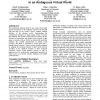Free Online Productivity Tools
i2Speak
i2Symbol
i2OCR
iTex2Img
iWeb2Print
iWeb2Shot
i2Type
iPdf2Split
iPdf2Merge
i2Bopomofo
i2Arabic
i2Style
i2Image
i2PDF
iLatex2Rtf
Sci2ools
74
Voted
GECCO
2005
Springer
2005
Springer
Evolving visually guided agents in an ambiguous virtual world
The fundamental challenge faced by any visual system within natural environments is the ambiguity caused by the fact that light that falls on the system’s sensors conflates multiple attributes of the physical world. Understanding the computational principles by which natural systems overcome this challenge and generate useful behaviour remains the key objective in neuroscience and machine vision research. In this paper we introduce Mosaic World, an artificial life model that maintains the essential characteristics of natural visual ecologies, and which is populated by virtual agents that – through ‘natural’ selection – come to resolve stimulus ambiguity by adapting the functional structure of their visual networks according to the statistical structure of their ecological experience. Mosaic World therefore presents us with an important tool for exploring the computational principles by which vision can overcome stimulus ambiguity and usefully guide behaviour. Categories and ...
Related Content
| Added | 27 Jun 2010 |
| Updated | 27 Jun 2010 |
| Type | Conference |
| Year | 2005 |
| Where | GECCO |
| Authors | Ehud Schlessinger, Peter J. Bentley, R. Beau Lotto |
Comments (0)

